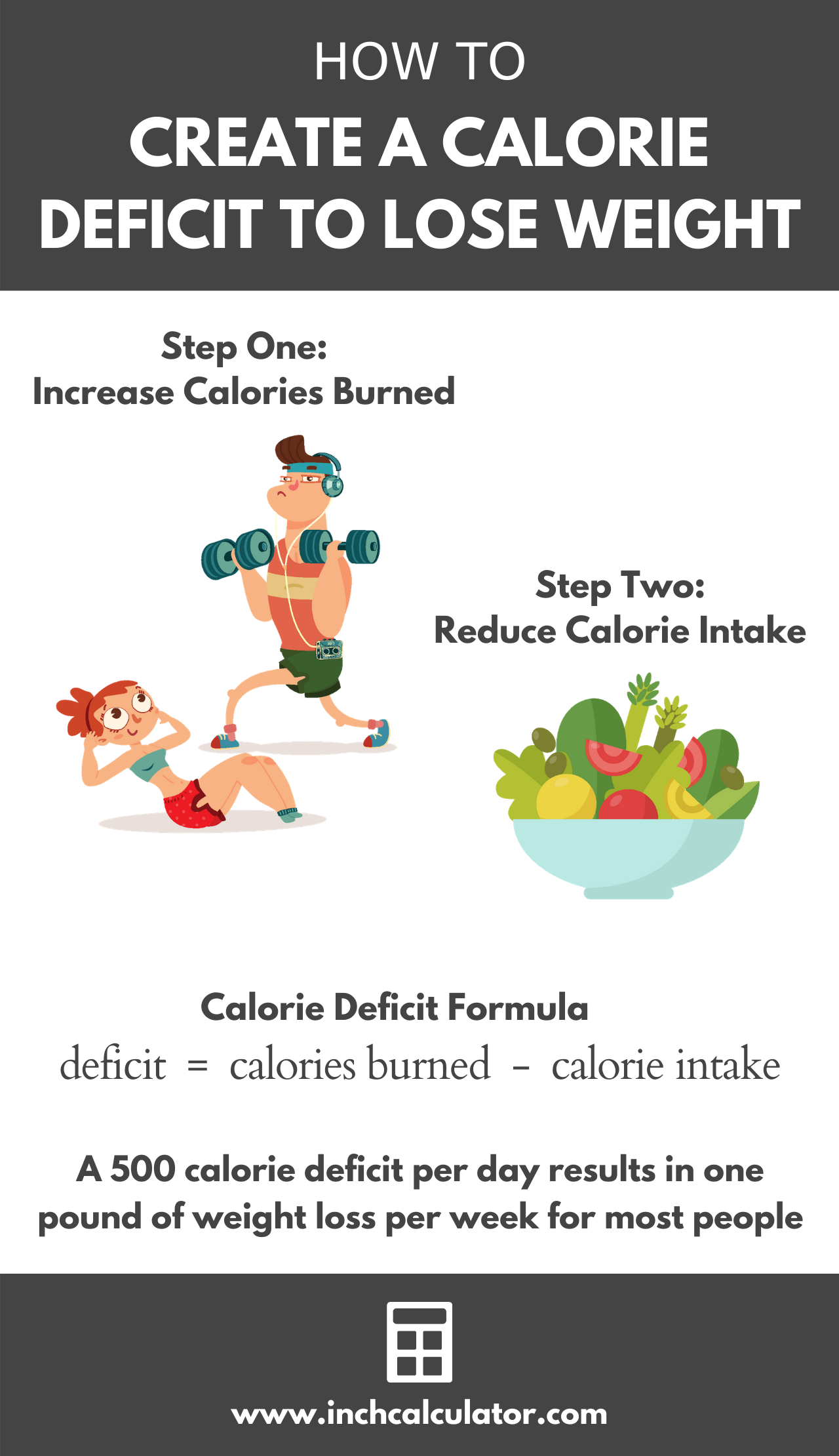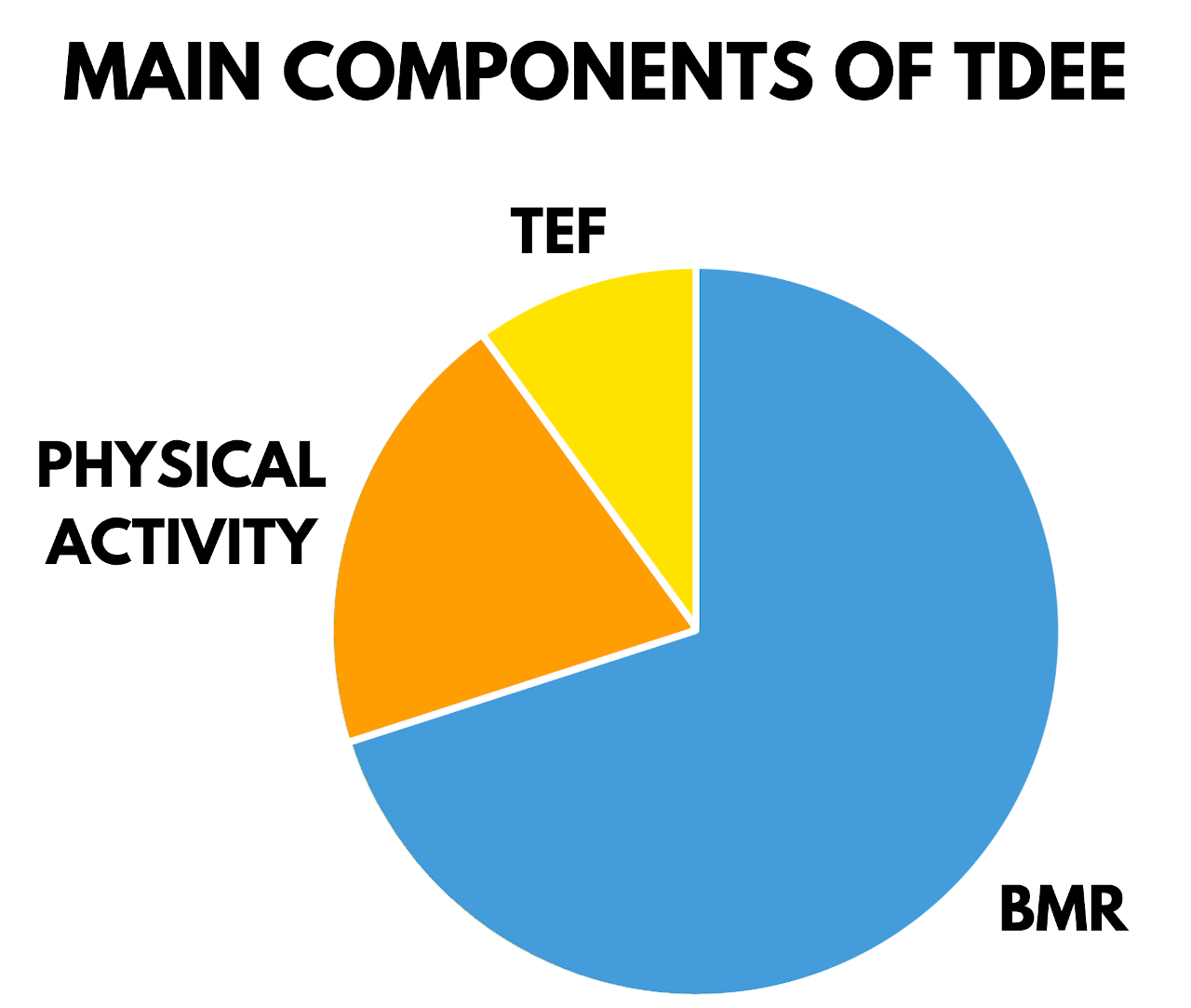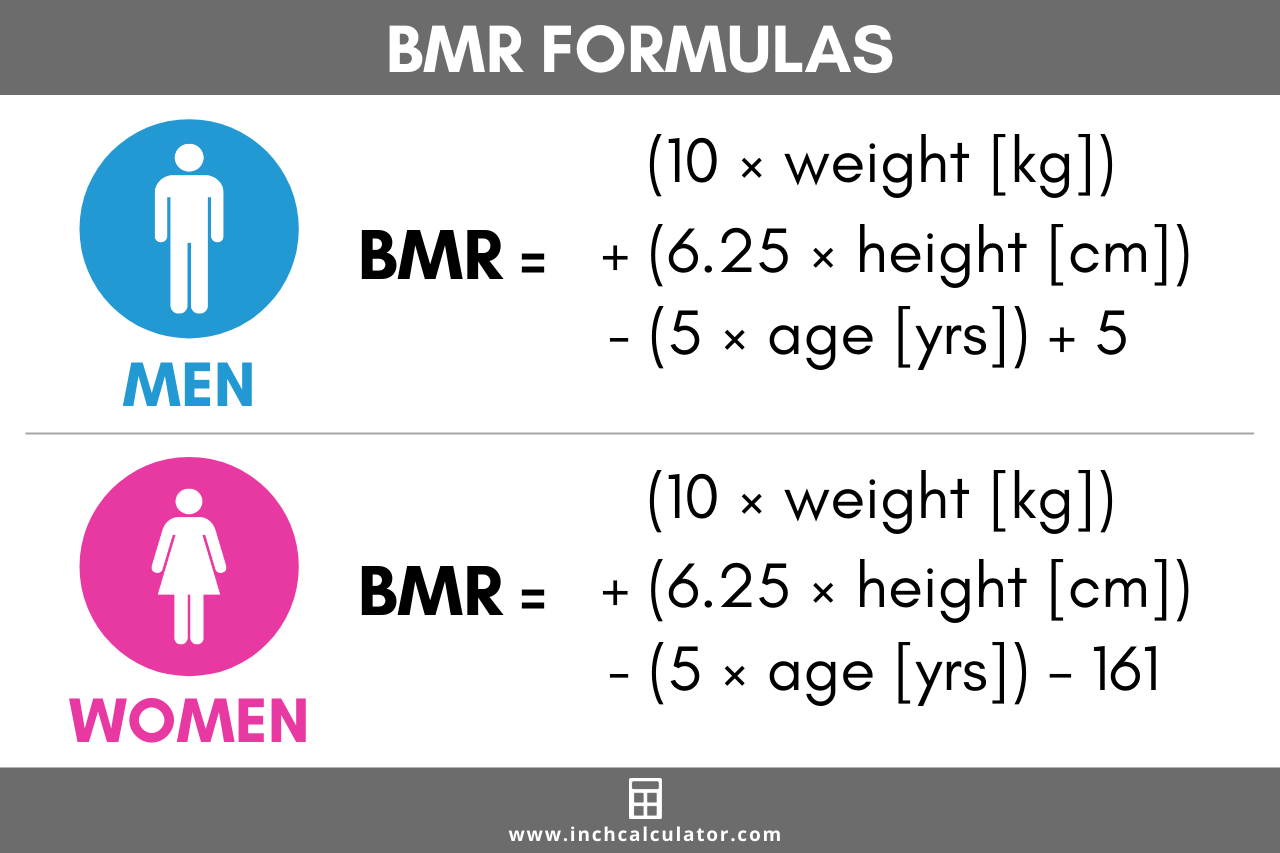Weight Loss Calculator – Calculate a Calorie Deficit to Lose Weight
Calculate the calorie deficit you need to lose weight using the calculator below.
Daily Calorie Requirements:
| Maintain Current Weight: | |
| Reach Goal Weight: | |
| Maintain Goal Weight: |
On this page:
- Weight Loss Calculator
- How to Create a Calorie Deficit
- How Many Calories to Lose a Pound
- How to Calculate Calorie Deficit for Weight Loss
- Step One: Calculate Your Daily Calorie Needs
- Step Two: Calculate an Optimal Calorie Deficit
- Things to Keep in Mind as You Implement a Calorie Deficit to Lose Weight
- References
How to Create a Calorie Deficit
Creating a calorie deficit means that you expend more energy, or calories, than you consume. This can be done by either decreasing calorie intake through your diet or by increasing calorie expenditure through physical activity.
In most cases, you want to do a combination of these two things to achieve healthy weight loss.
Many factors affect somebody’s ability to lose weight, and the most important factor is creating a calorie deficit.[2] In theory, if you want to lose weight, you need to burn more calories than you consume. Eat more calories than you burn, and you’ll gain weight. Burn more calories than you eat, and you’ll lose weight.
You can use this information to create a calorie deficit, and you can calculate it using a simple formula.
Calorie Deficit Formula
A calorie deficit is equal to calories burned minus calorie intake.
calorie deficit = calories burned – calorie intake
However, you should do this in a safe and calculated manner to avoid nutritional deficiencies or the development of unhealthy eating habits.

Calories equal energy, and you exert energy through all of your physical activities, from intense exercise to simply sitting at your desk doing office work. This is your “calories out.” Conversely, all the meals and snacks you consume count toward your “calories in.”
By increasing physical activity, you will burn more calories, the so-called “calories out.” Consuming healthier foods and counting calories will help you decrease your calorie intake, which is the “calories in” part of the equation for weight loss.
Then, use our weight loss percentage calculator to track your progress.
How Many Calories to Lose a Pound
A general estimate is that one pound is equivalent to about 3,500 calories. While this isn’t set in stone, it is a good starting point to help determine a calorie deficit for weight loss.
Using this number, decreasing caloric intake by 500 calories each day could result in a weight loss of about one pound a week. We need to emphasize that this is only an estimate since there are several other factors that play a role in weight loss, but it’s a good rule of thumb to use as a starting point.
How to Calculate Calorie Deficit for Weight Loss
If your goal is to lose weight, you can calculate the caloric intake of your new diet based on your total daily energy expenditure and your weight loss goal. A safe weight loss target is around 1 to 2 pounds a week.
Losing excessive weight too fast can result in adverse health effects and decreased metabolism. This can be counterproductive and can actually stall weight loss and even promote weight regain after calorie restrictions are lifted.[3]
Studies demonstrate that weight loss that occurs from exercise alone is usually smaller than expected. Weight loss is best achieved when there is a focus on both reducing caloric intake in addition to physical activity.[4]
By combining exercise and healthy eating, you can greatly increase the likelihood of not only losing weight, but also keeping the weight off.[4]
Step One: Calculate Your Daily Calorie Needs
To calculate how many calories you should eat including your calorie deficit, you have to figure out how much energy you expend on any given day. This is also known as your total daily energy expenditure (TDEE).
Your TDEE is made up of three main elements, although most calculations use only the first two elements. These include
Basal Metabolic Rate (BMR): Your basal metabolic rate is your metabolic rate while you are at rest. This is the number of calories your body burns when you are simply sitting and breathing.
BMR includes your body’s basic physiologic functions, such as breathing, heart rate, and brain activity.
Thermic Effect of Physical Activity (TEPA): The thermic effect of physical activity is the number of calories burned while your body is performing any type of movement or activity. This includes the energy you exert during exercise and the energy expended during non-exercise activities (non-exercise activity thermogenesis/NEAT).
NEAT consists of your simple daily tasks, like cleaning, folding clothes, or even just typing at your desk.
Thermic Effect of Food (TEF): The thermic effect of food is the number of calories your body needs to digest, absorb, and metabolize your food. TEF plays a minimal role in overall metabolism and is often not included in calculations used to estimate TDEE.
TEF generally accounts for no more than 10% of your BMR.[5]

How to Calculate BMR
Everyone has their own basal metabolic rate since this depends on each person’s individual physiology. BMR can actually be measured in a lab setting by indirect calorimetry to give a precise value of your metabolism.[6]
Indirect calorimetry works by measuring the heat that is produced by your body, which then gives a measure of the number of calories that you burn at rest.
Since most people don’t have access to an indirect calorimeter, formulas have been created to estimate BMR using age, gender, height, and weight. Some formulas even use lean body mass to more accurately predict BMR in certain populations.
The most widely used formulas for BMR are the Mifflin-St Jeor formula[7] and the Harris-Benedict equations.[8]
Mifflin-St Jeor BMR Formula
For Men:
BMR = (10 × weight [kg]) + (6.25 × height [cm]) – (5 × age [years]) + 5
For Women:
BMR = (10 × weight [kg]) + (6.25 × height [cm]) – (5 × age [years]) – 161

These formulas do not take lean body mass into account when calculating BMR. Since muscle mass has higher metabolic activity than fat mass, the Katch-McArdle equation was developed. This formula does take into account your lean body mass.
Athletes and individuals who are more muscular may find this formula to be more accurate when estimating BMR.
How to Calculate TDEE
Once you have determined your basal metabolic rate using any one of the BMR calculators above, the next step is to multiply this by an activity factor to calculate your TDEE. The activity factor is based on how much physical activity you do during formal exercise plus your activity at home and work.
TDEE Formula
TDEE = BMR × activity factor
Thus, your TDEE is equal to your BMR times the activity factor corresponding to your general level of activity. Refer to the table below showing the activity factor corresponding to levels of exertion:[9]
| Level of Activity | Example | Activity Factor |
|---|---|---|
| Sedentary | Little to no exercise, such as a desk job with no additional physical activity | 1.2 |
| Lightly Active | Light exercise 1-2 days/week | 1.375 |
| Moderately Active | Moderate exercise 3-5 days/week | 1.55 |
| Very Active | Hard exercise 6-7 days/week | 1.725 |
| Extremely Active | Hard daily exercise and physical job or two times a day training | 1.9 |
For example, a man with a BMR of 2,000 calories who is sedentary will have a total daily energy expenditure of 2,400 calories.
TDEE = 2,000 × 1.2 = 2,400 calories
Thermic Effect of Food
The thermic effect of food is harder to estimate and varies based on the type and amount of food that is consumed. Generally speaking, it is 10% or less of the total calories.
Since this is such a small number and can be tough to determine, it is often left out of equations. If you want to add this in yourself, you would multiply your BMR by 10%, and then multiply this final number by your activity factor.
TDEE = (BMR × 1.1) × activity factor
Continuing the example above, the equation to find this man’s TDEE accounting for TEF would look like this:
TDEE = (2,000 × 1.1) × 1.2 = 2,640 calories
Calorie Needs Based on Individual Activities
Most people will calculate their TDEE using an activity factor based on the amount of activity they generally do in a given day. However, there are days when you expend more energy through exercise or other activities.
To estimate your calorie needs on days where you do more exercise or activity than an average day, calculate the number of calories that you burn during specific exercises or activities to estimate how many additional calories you should consume. This is a great technique to keep your calorie intake in line on days where your exercise is more intense.
Find the MET Value
The energy your body uses when engaged in exercise can be expressed as the metabolic equivalent of task, or MET. This is a standardized number based on the type and intensity of the activity you are performing.
Activities that are more vigorous or longer in duration require more energy and subsequently will burn more calories. This means exercises like running and mountain climbing have higher MET values than walking.
To calculate the calories you burn during physical activities or exercise, you need to know the MET value for the activity. MET values for various activities can be found in the Compendium of Physical Activities,[10] or you can use our calories burned calculator to estimate the calories you burned.
Formula to Calculate Calories Burned
The formula to determine the number of calories burned based on physical activity is:
calories burned = time [min] × ((MET × 3.5) × weight [kg] ÷ 200)
You can then add the number of calories you burn in physical activity to your BMR instead of multiplying your BMR by an activity factor. This is another way to give you an estimate of how many calories you expend during the day.
TDEE = BMR + (total calories burned in activities)
This method is more time-consuming than simply using an activity factor since you have to do this for each activity you perform throughout the day for it to be accurate.
The quicker method to calculate TDEE is to simply multiply your BMR by an activity factor. As you might expect, this is less accurate and results in a more general estimate since it does not take each activity into account.
Step Two: Calculate an Optimal Calorie Deficit
Calculating your total daily energy expenditure will give you the number of calories you should consume to maintain your current body weight.
However, if your goal is to lose weight, you need to eat fewer calories than you expend. Remember, calories in should equal calories out to maintain your current weight, and calories in should be less than calories out to get a deficit.
As discussed above, you need to burn an estimated 3,500 calories to lose one pound. To lose this weight safely, you should aim to lose around 1 to 2 pounds a week. This is roughly equal to burning 500 to 1,000 calories a day more than you consume.
Calorie Deficit to Lose One Pound per Week:
500 calories daily
Calorie Deficit to Lose Two Pounds per Week:
1,000 calories daily
In the above example, the man needs to consume 2,400 calories to maintain his current weight. If he is trying to lose weight, however, he should decrease this calorie count by 500 to 1,000 calories daily, depending on his goal.
Daily Calorie Needs to Lose One Pound:
2,400 – 500 = 1,900 calories daily
Daily Calorie Needs to Lose Two Pounds:
2,400 – 1,000 = 1,400 calories daily
Things to Keep in Mind as You Implement a Calorie Deficit to Lose Weight
Creating a calorie deficit with a mix of smart dietary choices and increased physical activity results in safe weight loss that you’ll be able to maintain. It should be no surprise that diet and exercise are the keys to safe and effective weight loss.
In addition, as you lose weight, your basal metabolic rate will decline since this is based on your current weight. This means that over time, you will need to recalculate your BMR and TDEE based on your new weight.
Fortunately, you can easily do this using a calorie calculator for weight loss.
Keep in mind that all of the formulas here are only estimates. Many factors that are not able to be used in a calculator affect somebody’s ability to lose weight. Consulting with a dietitian or physician can help you formulate a weight loss program that is specific to your fitness goals and individual needs.
Similar Nutrition Calculators
References
- Harvard Medical School, Calorie counting made easy, Harvard Health Publishing, https://www.health.harvard.edu/staying-healthy/calorie-counting-made-easy
- Kim J. Y., Optimal Diet Strategies for Weight Loss and Weight Loss Maintenance, Journal of obesity & metabolic syndrome, 2021, 30(1), 20–31. https://doi.org/10.7570/jomes20065
- MacLean, P. S., Bergouignan, A., Cornier, M. A., & Jackman, M. R., Biology's response to dieting: the impetus for weight regain, American Journal of Physiology-Regulatory, Integrative and Comparative Physiology, 2011, https://journals.physiology.org/doi/full/10.1152/ajpregu.00755.2010
- Catenacci, V. A., & Wyatt, H. R., The role of physical activity in producing and maintaining weight loss, Nature Clinical Practice Endocrinology & Metabolism, 2007, 3(7), 518-529. https://www.nature.com/articles/ncpendmet0554
- Rising, R., Harper, I. T., Fontvielle, A. M., Ferraro, R. T., Spraul, M., & Ravussin, E., Determinants of total daily energy expenditure: variability in physical activity, The American journal of Clinical Nutrition, 1994, 59(4), 800-804. https://pubmed.ncbi.nlm.nih.gov/8147322/
- Delsoglio, M., Achamrah, N., Berger, M. M., & Pichard, C., Indirect Calorimetry in Clinical Practice, Journal of Clinical Medicine, 2019, 8(9), 1387. https://doi.org/10.3390/jcm8091387
- Mifflin, M. D., St Jeor, S. T., Hill, L. A., Scott, B. J., Daugherty, S. A., & Koh, Y. O., A new predictive equation for resting energy expenditure in healthy individuals, The American Journal of Clinical Nutrition, 1990, 51(2), 241-247. https://pubmed.ncbi.nlm.nih.gov/2305711/
- Roza, A. M., & Shizgal, H. M., The Harris Benedict equation reevaluated: resting energy requirements and the body cell mass, The American Journal of Clinical Nutrition, 1984, 40(1), 168–182. https://doi.org/10.1093/ajcn/40.1.168
- Kelly, M., Resting Metabolic Rate: Best Ways to Measure It—And Raise It, Too, American Council on Exercise, https://www.acefitness.org/certifiednewsarticle/2882/resting-metabolic-rate-best-ways-to-measure-it-and-raise-it-too/
- Ainsworth BE, Haskell WL, Herrmann SD, Meckes N, Bassett Jr DR, Tudor-Locke C, Greer JL, Vezina J, Whitt-Glover MC, Leon AS., The Compendium of Physical Activities Tracking Guide, Healthy Lifestyles Research Center, College of Nursing & Health Innovation, Arizona State University, https://pacompendium.com/



